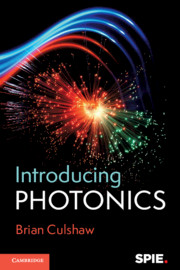22 results
4 - Light Interacting with Structures
-
- Book:
- Introducing Photonics
- Published online:
- 21 July 2020
- Print publication:
- 30 July 2020, pp 58-84
-
- Chapter
- Export citation
Index
-
- Book:
- Introducing Photonics
- Published online:
- 21 July 2020
- Print publication:
- 30 July 2020, pp 161-164
-
- Chapter
- Export citation
Preface
-
- Book:
- Introducing Photonics
- Published online:
- 21 July 2020
- Print publication:
- 30 July 2020, pp xi-xii
-
- Chapter
- Export citation
6 - The Future
-
- Book:
- Introducing Photonics
- Published online:
- 21 July 2020
- Print publication:
- 30 July 2020, pp 109-128
-
- Chapter
- Export citation
Appendix 2 - The Fourier Transform Properties of Lenses
-
- Book:
- Introducing Photonics
- Published online:
- 21 July 2020
- Print publication:
- 30 July 2020, pp 132-135
-
- Chapter
- Export citation
Copyright page
-
- Book:
- Introducing Photonics
- Published online:
- 21 July 2020
- Print publication:
- 30 July 2020, pp vi-vi
-
- Chapter
- Export citation
Reviews
-
- Book:
- Introducing Photonics
- Published online:
- 21 July 2020
- Print publication:
- 30 July 2020, pp ii-iv
-
- Chapter
- Export citation
Appendices
-
- Book:
- Introducing Photonics
- Published online:
- 21 July 2020
- Print publication:
- 30 July 2020, pp 129-156
-
- Chapter
- Export citation
Appendix 5 - Some Fundamental Constants
-
- Book:
- Introducing Photonics
- Published online:
- 21 July 2020
- Print publication:
- 30 July 2020, pp 142-142
-
- Chapter
- Export citation
Appendix 1 - More About the Polarisation of Waves
-
- Book:
- Introducing Photonics
- Published online:
- 21 July 2020
- Print publication:
- 30 July 2020, pp 129-131
-
- Chapter
- Export citation
Appendix 6 - Comments and Hints on Chapter Problems
-
- Book:
- Introducing Photonics
- Published online:
- 21 July 2020
- Print publication:
- 30 July 2020, pp 143-156
-
- Chapter
- Export citation
3 - Light Interacting with Materials
-
- Book:
- Introducing Photonics
- Published online:
- 21 July 2020
- Print publication:
- 30 July 2020, pp 25-57
-
- Chapter
- Export citation
2 - The Nature of Light
-
- Book:
- Introducing Photonics
- Published online:
- 21 July 2020
- Print publication:
- 30 July 2020, pp 11-24
-
- Chapter
- Export citation
Contents
-
- Book:
- Introducing Photonics
- Published online:
- 21 July 2020
- Print publication:
- 30 July 2020, pp vii-x
-
- Chapter
- Export citation
Appendix 4 - The Concepts of Phase and Group Velocity
-
- Book:
- Introducing Photonics
- Published online:
- 21 July 2020
- Print publication:
- 30 July 2020, pp 139-141
-
- Chapter
- Export citation
Appendix 3 - The Clausius–Mossotti Equation and the Frequency Dependence of the Refractive Index
-
- Book:
- Introducing Photonics
- Published online:
- 21 July 2020
- Print publication:
- 30 July 2020, pp 136-138
-
- Chapter
- Export citation
Further Reading
-
- Book:
- Introducing Photonics
- Published online:
- 21 July 2020
- Print publication:
- 30 July 2020, pp 157-160
-
- Chapter
- Export citation
5 - Photonic Tools
-
- Book:
- Introducing Photonics
- Published online:
- 21 July 2020
- Print publication:
- 30 July 2020, pp 85-108
-
- Chapter
- Export citation
1 - Photonics – An Introduction
-
- Book:
- Introducing Photonics
- Published online:
- 21 July 2020
- Print publication:
- 30 July 2020, pp 1-10
-
- Chapter
- Export citation

Introducing Photonics
-
- Published online:
- 21 July 2020
- Print publication:
- 30 July 2020

